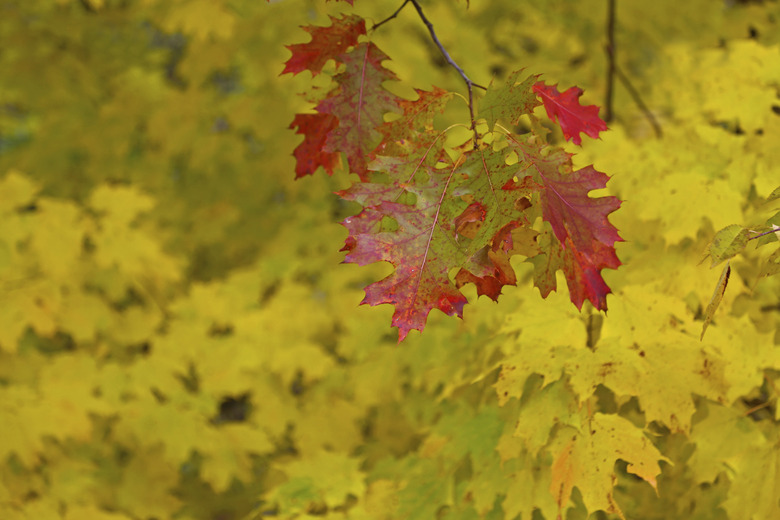What Is The Difference Between Maple And Oak Trees?
We may receive a commission on purchases made from links.
Two of the most popular trees in the United States, maples (Acer spp.) and oaks (Quercus spp.) complement one another in nature and in planned landscapes. Maples range in hardiness from U.S. Department of Agriculture plant hardiness zones 2 through 10, with oaks hardy from USDA zones 3 through 10. These wide-ranging genera have significant differences within their groups, as well as differences between maple and oak trees. Even so, some general characteristics define these valued trees.
Ornamental Contrasts Between Maple and Oak Trees
Ornamental Contrasts Between Maple and Oak Trees
Many maples have striking fall foliage from bright yellow and orange to fiery red and all drop their leaves. Oaks offer rich, muted tones of gold, red, brown and russet, and some southern oaks stay evergreen. All maples have flowers, with red maples (Acer rubrum), hardy from USDA zones 3 through 9, especially vibrant and showy. Oaks share drooping catkins and small spikes.
Maple fruit, known as samaras, pair winged nutlets that spin like whirlybirds. Oaks offer distinctive acorn fruit, different for every species; some mature in one year, others take two. Maple leaves always occur opposite one another along the twig; leaf veins run like outstretched fingers from a common base. Oak twigs reveal alternate leaves with main center veins from base to tip.
Cultural Variations Between Maples and Oaks
Cultural Variations Between Maples and Oaks
In general, maple and oak trees prefer rich, porous, well-drained soil and full sun to part shade locations. Slightly acidic soil pH suits them best, with some oak and maple species sensitive to alkalinity. One example is pin oak (Quercus palustris), hardy in USDA zones 4 through 8, which develops chlorotic leaves when high soil pH makes iron unavailable.
Maples tend to require more moisture – especially red maples – and develop more shallow surface roots than oaks. Established oaks show greater drought tolerance. Some have deep taproots that resist transplanting. Proper care is especially important for potentially large trees. Once mature, their size often makes insect and disease treatments unfeasible.
Oak and Maple Tree Landscape Diversity
Oak and Maple Tree Landscape Diversity
Maples and oaks fit urban spaces and wide-open landscapes. They run from small trees such as "Burgundy Lace" Japanese maple (Acer palmatum "Burgundy Lace"), hardy in USDA zones 5 through 9 and just 8 to 12 feet tall, to sugar maples (Acer saccharum) that reach 100 feet tall in USDA zones 3 through 8.
Smaller oaks such as downy oak (Quercus pubescens var. crispata), under 20 feet tall and wide in USDA zones 5 through 8, compare to spreading bur oaks (Quercus macrocarpa) that can reach 150 feet in height in USDA zones 3 through 8. White oaks (Quercus alba), hardy in USDA zones 3 through 9, grow up to 100 feet tall and wide with massive trunks up to 6 feet in diameter.
Pruning Differences Between Maples and Oaks
Pruning Differences Between Maples and Oaks
When pruned in late winter, maples bleed sap just like trees tapped for syrup. It doesn't harm them, but dried sap can be unattractive. Prune maples in late summer instead. Take care with mowers and trimmers also; maples have thin, easily damaged bark. Prune oaks in the dead of winter to prevent the spread of oak wilt. Northern gardeners never prune oaks from April to November; southerners stop even earlier.
Beetles attracted to fresh oak wounds spread the lethal fungal disease. Oak pruning must take place before beetles become active. For maple and oak trees, as well as all others, do major pruning early in life, so pruning wounds stay small. Use sharp bypass pruners or pruning saws. To prevent spreading disease, sterilize your blades with rubbing alcohol before and after each tree.
